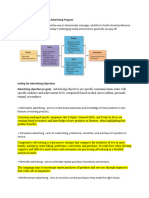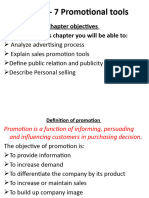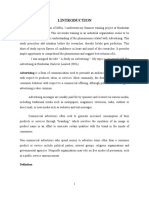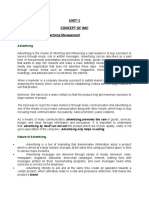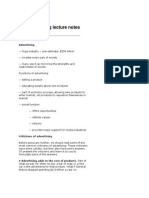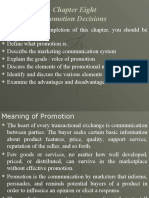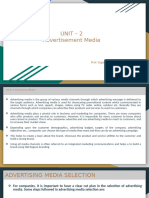Advertising
Advertising
Uploaded by
Dinesh KumarCopyright:
Available Formats
Advertising
Advertising
Uploaded by
Dinesh KumarCopyright
Available Formats
Share this document
Did you find this document useful?
Is this content inappropriate?
Copyright:
Available Formats
Advertising
Advertising
Uploaded by
Dinesh KumarCopyright:
Available Formats
advertising - effectiveness?
Judging the effectiveness of advertising How can the effectiveness of an advert be judged? The answer depends on what objectives or tasks were set for the advert. The table below sets out some possible objectives/tasks and how the effectiveness of the advert might be measured: Advertising objective Stimulate an increase in sales Remind customers of the existence of a product Inform customers How success can be measured - Number of enquiries from advert - Number of enquiries converted into sales - Test customer awareness both before and after the advertising campaign - Number of enquiries - Test customer awareness - Number of requests for further information -Sales -Test customer awareness of brand recognition and perceived values - Levels of repeat purchase - Levels of customer retention - Measure demographic profile of purchases - Measure type of goods ordered by new purchasers - Compare with previous data
Build a brand image Build customer loyalty and relationship
Change customer attitudes
Objectives of the study: To study the effectiveness of advertisement of products under study in newspapers. To study the effectiveness of advertisement of products understudy in TV Media To analyze and compare the consumers attitude towards advertisement in TV and newspaper Media. The effectiveness of advertisement of products under
study in newspapers.
effectiveness of advertisement
Advertisement is a communication whose purpose is to inform potential customers about products and services and how to use and obtain them. Every major medium is used to deliver these messages, including: television, radio, movies, magazines, newspapers, and internet. It is often placed by an advertising agency on behalf of a company. Advertisement influence our lives in many unsuspecting ways because of rapid changes in the macro environment. These days advertising is regarded as a paid form of nonpersonal presentation of ideas, goods and services by an identified sponsor Testing or evaluation of advertising effectiveness refers to the managerial exercise aimed at relating the advertising results to the established standards of performance and objectives so as to assess the real value of the advertising performance. This evaluation exercise is also known as the advertising research. It is a research activity undertaken to measure the worth of the specific elements of an advertisement or the aspects of entire advertising programme. It is an attempt to know whether the message designed properly has reached the greatest number of prospects at the least practical cost. There are various types of media use for advertising these are: print media, electronic media etc. Of all the media, newspaper is considered as the backbone of advertising programme as it has continued to remain the most powerful message carrier. Of the total space, 45 percent goes to advertisements in form or the other and rest for textual matter. Television is the youngest, glamorous and highly specialized as it provides -1scientific synchronization of sound, light, motion, colour and immediacy that no other medium does except film. Colour transmission started in 1982 on the eve of ASIAD-82. It is state owned and controlled and is known as DOORDARSHAN. The telecasting system based on coverage is of two types namely, V.H.F. and U.H.F. the latest one is C.A.T.V. which means Community Antenna Television System. Now it is better known as Cable Television. -2Need of the Study
The average consumer is exposed to more than 1,500 advertising messages everyday. Advertising is everywhere. People may be most conscious of advertising when they watch television, but advertising in its many forms nevertheless pervades society, invades
households, and persuades minds nearly every waking moment. And it is not likely to abate any time soon. Company newsletters now frequently carry advertisements. Just 10 years ago, an arena was just an arena, and the baseball park was called Milwaukee County Stadium. To manage costs, naming rights to such venues are now offered. Midwest Express Airlines and Miller Brewing remind people of their generosity (and available cash) every time people pass "their" buildings. Advertising is everywhere. But nowhere is it more apparent than on your television screen. New research released by an advertising industry trade group says the number of television commercials, public service announcements, and station promotions reached an all-time high last year. And it's not because the networks think viewers need more time to fix a snack or go to the bathroom. "Costs are going up," says a CBS executive. "And advertising is what covers those costs." In the average hour, only about 39 minutes is devoted to programming. The balance is called "clutter." Clutter worries the advertising industry. They figure the more commercials stuffed into an hour, the less likely viewers are to remember their clients' ads. Clutter, whether on television or in any medium, also makes their job harder. It's up to the advertising agency to create commercials for their clients that stand out from the rest ofthe commercials. There ads must communicate their client's message more clearly and be better remembered than the muddle of mediocrity that exists among most advertisements. The ads must have punch; make the reader stop from turning the page or the viewer stop from changing the channel. They must break the "boredom barrier." In short, good advertising must have impact. It's a fundamental precept of all advertising. The need was felt to investigate the issues and clutter in advertisement, print and electronic media.
There are five main stages in a well-managed advertising campaign: Stage 1: Set Advertising Objectives An advertising objective is a specific communication task to be achieved with a specific target audience during a specified period of time. Advertising objectives fall into three main categories: (a) To inform - e.g. tell customers about a new product (b) To persuade - e.g. encourage customers to switch to a different brand (c) To remind - e.g. remind buyers where to find a product Stage 2: Set the Advertising Budget
Marketers should remember that the role of advertising is to create demand for a product. The amount spent on advertising should be relevant to the potential sales impact of the campaign. This, in turn will reflect the characteristics of the product being advertised. For example, new products tend to need a larger advertising budget to help build awareness and to encourage consumers to trial the product. A product that is highly differentiated may also need more advertising to help set it apart from the competition emphasising the points of difference. Setting the advertising budget is not easy - how can a business predict the right amount to spend. Which parts of the advertising campaign will work best and which will have relatively little effect? Often businesses use "rules-of-thumb" (e.g. advertising/sales ratio) as a guide to set the budget. Stage 3: Determine the key Advertising Messages Spending a lot on advertising does not guarantee success (witness the infamous John Cleese campaign for Sainsbury). Research suggests that the clarity of the advertising message is often more important than the amount spent. The advertising message must be carefully targeted to impact the target customer audience. A successful advertising message should have the following characteristics: (a) Meaningful - customers should find the message relevant (b) Distinctive - capture the customer's attention (c) Believable - a difficult task, since research suggests most consumers doubt the truth of advertising in general Stage 4: Decide which Advertising Media to Use There are a variety of advertising media from which to chose. A campaign may use one or more of the media alternatives. The key factors in choosing the right media include: (a) Reach - what proportion of the target customers will be exposed to the advertising? (b) Frequency - how many times will the target customer be exposed to the advertising message? (c) Media Impact - where, if the target customer sees the message - will it have most impact? For example does an advert promoting holidays for elderly people have more impact on Television (if so, when and which channels) or in a national newspaper or perhaps a magazine focused on this segment of the population? Another key decision in relation to advertising media relates to the timing of the campaign. Some products are particularly suited to seasonal campaigns on television (e.g.
Christmas hampers) whereas for other products, a regular advertising campaign throughout the year in media such as newspapers and specialist magazines (e.g. cottage holidays in the Lake District) is more appropriate. Stage 5: Evaluate the results of the Advertising Campaign The evaluation of an advertising campaign should focus on two key areas: (1) The Communication Effects - is the intended message being communicated effectively and to the intended audience? (2) The Sales Effects - has the campaign generated the intended sales growth. This second area is much more difficult to measure.
You might also like
- Lesson Plan - Assignment 1Document20 pagesLesson Plan - Assignment 1Callame Fagri92% (13)
- Managing Mass CommunicationDocument20 pagesManaging Mass CommunicationAneesh VargheseNo ratings yet
- AdvertisingDocument27 pagesAdvertisingNirvair MogaNo ratings yet
- ADVERTISINGDocument15 pagesADVERTISINGPalak DeepNo ratings yet
- Managing Mass Communications AdvertisingDocument21 pagesManaging Mass Communications AdvertisingPhạm Anh TuấnNo ratings yet
- Aims of Advertising (Rövidített Tétel)Document4 pagesAims of Advertising (Rövidített Tétel)herczegnebaloghagnesNo ratings yet
- Advertisement Media and AppealsDocument42 pagesAdvertisement Media and Appealsharshit naharNo ratings yet
- Advertising Definition: 1) Mission: What Are The Advertising Objectives?Document11 pagesAdvertising Definition: 1) Mission: What Are The Advertising Objectives?bismayhalderNo ratings yet
- Developing and Managing An Advertising ProgramDocument13 pagesDeveloping and Managing An Advertising Programashgaming951No ratings yet
- ch-8Document36 pagesch-8amogneNo ratings yet
- Chapter 15 Advertising and Public RelationsDocument6 pagesChapter 15 Advertising and Public RelationsTaylor KalinowskiNo ratings yet
- MK0007 - Advertising Management and Sales Promotion Assignment Set-1Document16 pagesMK0007 - Advertising Management and Sales Promotion Assignment Set-1Tushar PatilNo ratings yet
- Competitive Advertising: by Dipesh TekchandaniDocument28 pagesCompetitive Advertising: by Dipesh TekchandaniDipesh Tekchandani100% (1)
- Chapter-Three Advertising: IMC-Lecture NoteDocument14 pagesChapter-Three Advertising: IMC-Lecture NoteAsaminow GirmaNo ratings yet
- Unit 1 AdvertisingDocument21 pagesUnit 1 AdvertisingtdhvikasagarwalNo ratings yet
- Chapter 7 Promotional Tools.Document16 pagesChapter 7 Promotional Tools.kichuubmcNo ratings yet
- AnkitaDocument36 pagesAnkitaaashish solankiNo ratings yet
- Chapter-Managing Mass CommunicationDocument3 pagesChapter-Managing Mass CommunicationF A E KhanNo ratings yet
- Decision Models, Sales Response & Decay ModelsDocument3 pagesDecision Models, Sales Response & Decay ModelsRamadurga PillaNo ratings yet
- Advertising and Sales (DBB2105)Document12 pagesAdvertising and Sales (DBB2105)2004singhalvasuNo ratings yet
- Ethical Issue in Marketing Communication &advertising As A Manegement FuncationDocument15 pagesEthical Issue in Marketing Communication &advertising As A Manegement FuncationJitendra Virahyas100% (4)
- Marketing ManagementDocument69 pagesMarketing ManagementNaveed IqbalNo ratings yet
- M20 (Advertising, Copy Creation and Feedback On The Net) Academic ScriptDocument16 pagesM20 (Advertising, Copy Creation and Feedback On The Net) Academic ScriptNitin KumarNo ratings yet
- Kotler MM 14e 18 Ippt PDFDocument34 pagesKotler MM 14e 18 Ippt PDFAloysius Derry BenediktusNo ratings yet
- The Sum of The Reach Number of Specific Media Vehicles in A Given Media Plan Gives The Message Weight Is Expressed in Terms of Gross Impressions or Gross Rating Points (GRP)Document10 pagesThe Sum of The Reach Number of Specific Media Vehicles in A Given Media Plan Gives The Message Weight Is Expressed in Terms of Gross Impressions or Gross Rating Points (GRP)keen writerNo ratings yet
- A Study On Advertising of HULDocument60 pagesA Study On Advertising of HULramki3435100% (1)
- Unit - 1Document5 pagesUnit - 1ChaiTanYa KumarNo ratings yet
- 9T-Ani Aims of Adv. (Bence)Document9 pages9T-Ani Aims of Adv. (Bence)herczegnebaloghagnesNo ratings yet
- AdvertisingDocument38 pagesAdvertisingShradha SaxenaNo ratings yet
- Business Marketing CHAPTER 11Document17 pagesBusiness Marketing CHAPTER 11Charisse Mae MendozaNo ratings yet
- Advertising Lecture NotesDocument18 pagesAdvertising Lecture NotesNeha RastogiNo ratings yet
- Module 4 MM6 Developing and Managing Advertising ProgramDocument46 pagesModule 4 MM6 Developing and Managing Advertising ProgramNick Allan PiojoNo ratings yet
- Business and Media CommunicationDocument7 pagesBusiness and Media CommunicationsanaNo ratings yet
- Abm InternalDocument24 pagesAbm InternalDiksha YadvNo ratings yet
- Media Planning in AdvertisingDocument4 pagesMedia Planning in AdvertisingVed Pareek100% (2)
- Advertising CampaignsDocument7 pagesAdvertising CampaignsErock21No ratings yet
- Chapter Eight Promotion DecisionsDocument35 pagesChapter Eight Promotion DecisionsYeshambel EwunetuNo ratings yet
- Developing and Managing An Advertising ProgrammeDocument3 pagesDeveloping and Managing An Advertising ProgrammemierameaNo ratings yet
- Sumit YadavDocument85 pagesSumit Yadavanuj3026No ratings yet
- Introduction On THE ROLE OF ADVERTISEMENT MEDIA ON CONSUMER BUYINGDocument30 pagesIntroduction On THE ROLE OF ADVERTISEMENT MEDIA ON CONSUMER BUYINGVaibhav RautNo ratings yet
- 5M's of AdvertisingDocument7 pages5M's of AdvertisingShoury Anand100% (3)
- Impact of Advertising On Sales of New ProductDocument15 pagesImpact of Advertising On Sales of New Productshantilal panchalNo ratings yet
- KIRAN PRojectDocument69 pagesKIRAN PRojectMunna Munna100% (2)
- Pom - Chapter EightDocument10 pagesPom - Chapter EightyetnayettseNo ratings yet
- Advertising and Public RelationsDocument34 pagesAdvertising and Public RelationsTahmidur Rahman TonmoyNo ratings yet
- Setting The Advertising Objectives (Advertising Goal/Objective)Document4 pagesSetting The Advertising Objectives (Advertising Goal/Objective)Ahraz Ali DurraniNo ratings yet
- BBA EAMM Unit 1Document24 pagesBBA EAMM Unit 1varun bhaskarNo ratings yet
- MB0030 - Marketing ManagementDocument15 pagesMB0030 - Marketing ManagementKanchan WadhwaNo ratings yet
- ADV and SP Unit 2Document20 pagesADV and SP Unit 2Pulkit DubeyNo ratings yet
- Meaning of Advertising: Advertising Is A Form of Communication For Marketing and Used To Encourage, Persuade, orDocument43 pagesMeaning of Advertising: Advertising Is A Form of Communication For Marketing and Used To Encourage, Persuade, orJorawar DeolNo ratings yet
- Ex:-Tata Indigo: - Class Starts EarlyDocument10 pagesEx:-Tata Indigo: - Class Starts Earlyakash nillNo ratings yet
- Advertising, Sales, Promotion, and Public RelationsDocument24 pagesAdvertising, Sales, Promotion, and Public RelationsShaukat Ali KhanNo ratings yet
- Marketing ManagementDocument8 pagesMarketing ManagementKhamizi KhalidNo ratings yet
- Appeal To Your Customers With Effective Ad CopywritingDocument21 pagesAppeal To Your Customers With Effective Ad CopywritingChaitu BablooNo ratings yet
- Mail: 'P 'P 'P 'P 'P 'P 'P 'P 'P 'P 'P 'P 'P 'P 'P 'P 'PDocument10 pagesMail: 'P 'P 'P 'P 'P 'P 'P 'P 'P 'P 'P 'P 'P 'P 'P 'P 'PMohamad SayeedNo ratings yet
- MY PROJECT (14-10-22)Document79 pagesMY PROJECT (14-10-22)Omoh MichaelNo ratings yet
- "ROLE OF ADVERTISING IN FMCG SECTOR" FinalDocument95 pages"ROLE OF ADVERTISING IN FMCG SECTOR" Finaldheerajkumarrajput75% (8)
- Advertising Made Easy: How to Create Campaigns That Capture AttentionFrom EverandAdvertising Made Easy: How to Create Campaigns That Capture AttentionNo ratings yet
- Concise Guide to Internet Marketing for the EntrepreneurFrom EverandConcise Guide to Internet Marketing for the EntrepreneurNo ratings yet
- Traditional Education and e EducationDocument10 pagesTraditional Education and e EducationSunnyKumarNo ratings yet
- Unit 9Document12 pagesUnit 9cykablyatNo ratings yet
- Sow English Year 4 2022-2023Document14 pagesSow English Year 4 2022-2023anurada17No ratings yet
- Choral 6-7 8 Lesson 11Document2 pagesChoral 6-7 8 Lesson 11api-300277282No ratings yet
- College Comparison Essay ExampleDocument4 pagesCollege Comparison Essay Exampleb6yf8tcd100% (2)
- Social Work Research Literature ReviewDocument8 pagesSocial Work Research Literature Reviewdowxgtbnd100% (2)
- MKT AssDocument2 pagesMKT AssAmir KashroNo ratings yet
- Level 3 Open Internet Comments - March 2014Document16 pagesLevel 3 Open Internet Comments - March 2014jbrodkin2000No ratings yet
- Local Heritage MatrixDocument3 pagesLocal Heritage MatrixDonabelEscotaEspaño100% (1)
- Entrep ReviewerDocument3 pagesEntrep ReviewerKit DyNo ratings yet
- Lesson Plan 03Document8 pagesLesson Plan 03api-240976277No ratings yet
- Makalah EnglishDocument7 pagesMakalah EnglishThoriq Dani RahmansyahNo ratings yet
- Theories of Personal Selling: Submitted By:-Submitted ToDocument13 pagesTheories of Personal Selling: Submitted By:-Submitted ToVinod SethNo ratings yet
- Department of Education: Doña Basilia S. Quilon Memorial High SchoolDocument2 pagesDepartment of Education: Doña Basilia S. Quilon Memorial High SchoolRaquel Bona ViñasNo ratings yet
- TVL CSS11 Q4 M8Document16 pagesTVL CSS11 Q4 M8Richard Sugbo100% (1)
- Integrated Numeracy and ICT Lesson Plan: Teacher Content KnowledgeDocument6 pagesIntegrated Numeracy and ICT Lesson Plan: Teacher Content Knowledgeapi-377763349No ratings yet
- Difference Between Buzz Vs Viral MarketingDocument15 pagesDifference Between Buzz Vs Viral MarketingWachyu DarojatNo ratings yet
- MKT 460 Course OutlineDocument9 pagesMKT 460 Course OutlineFahad Feroz0% (1)
- Visual Argument Assignment: Peer Review FormDocument3 pagesVisual Argument Assignment: Peer Review FormmamcgillNo ratings yet
- CVEnglish CelineBernatowicz.Document1 pageCVEnglish CelineBernatowicz.Celine BernatowiczNo ratings yet
- Why Sponsor NogofDocument4 pagesWhy Sponsor NogofHussein BoffuNo ratings yet
- Trends and FadDocument11 pagesTrends and FadMarcelo SakitingNo ratings yet
- Section B Moodle Assignment Practice Question - Apple Module 3 Tri 2, 21Document2 pagesSection B Moodle Assignment Practice Question - Apple Module 3 Tri 2, 21Shedrine WamukekheNo ratings yet
- Ltrt-95206 Mediant 3000 + Tp-6310 Mgcp+Megaco User's Manual Ver 5.6Document194 pagesLtrt-95206 Mediant 3000 + Tp-6310 Mgcp+Megaco User's Manual Ver 5.6Aleksey MelnikovNo ratings yet
- MS 4 - 2nd Generation Sequence Three - Healthy Food and Citizenship - All Lessons by Khelil Moudjib Arrahmane 2018-2019Document27 pagesMS 4 - 2nd Generation Sequence Three - Healthy Food and Citizenship - All Lessons by Khelil Moudjib Arrahmane 2018-2019Syed Anwer Shah100% (1)
- Understanding Bridge Resource Management and Its Key Elements On Board ShipsDocument2 pagesUnderstanding Bridge Resource Management and Its Key Elements On Board ShipsValentino Lobo100% (1)
- Please CheckDocument34 pagesPlease CheckdikpalakNo ratings yet
- Over ProvisioningDocument3 pagesOver ProvisioningscribdslaskNo ratings yet
- Wesley Chinese Curriculum Map Myp Novice HighDocument4 pagesWesley Chinese Curriculum Map Myp Novice Highapi-273234945No ratings yet








